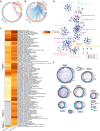Breaking the Mucin Barrier: A New Affinity Chromatography-Mass Spectrometry Approach to Unveil Potential Cell Markers and Pathways Altered in Pseudomyxoma Peritonei
- PMID: 38750435
- PMCID: PMC11094946
- DOI: 10.1186/s12575-024-00239-0
Breaking the Mucin Barrier: A New Affinity Chromatography-Mass Spectrometry Approach to Unveil Potential Cell Markers and Pathways Altered in Pseudomyxoma Peritonei
Abstract
Background: Pseudomyxoma peritonei (PMP) is a rare peritoneal mucinous carcinomatosis with largely unknown underlying molecular mechanisms. Cytoreductive surgery combined with hyperthermic intraperitoneal chemotherapy is the only therapeutic option; however, despite its use, recurrence with a fatal outcome is common. The lack of molecular characterisation of PMP and other mucinous tumours is mainly due to the physicochemical properties of mucin.
Results: This manuscript describes the first protocol capable of breaking the mucin barrier and isolating proteins from mucinous tumours. Briefly, mucinous tumour samples were homogenised and subjected to liquid chromatography using two specific columns to reduce mainly glycoproteins, albumins and immunoglobulin G. The protein fractions were then subjected to mass spectrometry analysis and the proteomic profile obtained was analysed using various bioinformatic tools. Thus, we present here the first proteome analysed in PMP and identified a distinct mucin isoform profile in soft compared to hard mucin tumour tissues as well as key biological processes/pathways altered in mucinous tumours. Importantly, this protocol also allowed us to identify MUC13 as a potential tumour cell marker in PMP.
Conclusions: In sum, our results demonstrate that this protein isolation protocol from mucin will have a high impact, allowing the oncology research community to more rapidly advance in the knowledge of PMP and other mucinous neoplasms, as well as develop new and effective therapeutic strategies.
Keywords: Cancer; MUC13; Mucin; Protein; Pseudomyxoma peritonei.
© 2024. The Author(s).
Conflict of interest statement
The authors declare no competing interests.
Figures






References
-
- Arjona-Sánchez Á, Muñoz-Casares FC, Rufián-Peña S, Díaz-Nieto R, Casado-Adam Á, Rubio-Pérez MJ, et al. Pseudomyxoma peritonei treated by cytoreductive surgery and hyperthermic intraperitoneal chemotherapy: results from a single centre. Clin Transl Oncol. 2011;13:261–7. doi: 10.1007/s12094-011-0651-8. - DOI - PubMed
-
- Arjona-Sánchez Á, Muñoz-Casares FC, Casado-Adam Á, Sánchez-Hidalgo JM, Teran MDA, Orti-Rodriguez R, et al. Outcome of Patients with Aggressive Pseudomyxoma Peritonei Treated by Cytoreductive Surgery and Intraperitoneal Chemotherapy. World J Surg. 2013;37:1263–70. doi: 10.1007/s00268-013-2000-2. - DOI - PubMed
-
- Baratti D, Kusamura S, Milione M, Bruno F, Guaglio M, Deraco M. Validation of the Recent PSOGI Pathological Classification of Pseudomyxoma Peritonei in a Single-Center Series of 265 Patients Treated by Cytoreductive Surgery and Hyperthermic Intraperitoneal Chemotherapy. Ann Surg Oncol. 2017;25:1–10. - PubMed
Grants and funding
- PI22/01213/Instituto de Salud Carlos III
- PI22/01213/Instituto de Salud Carlos III
- PI22/01213/Instituto de Salud Carlos III
- PI22/01213/Instituto de Salud Carlos III
- PI22/01213/Instituto de Salud Carlos III
- PI22/01213/Instituto de Salud Carlos III
- PI22/01213/Instituto de Salud Carlos III
- PI22/01213/Instituto de Salud Carlos III
- PI22/01213/Instituto de Salud Carlos III
- PI22/01213/Instituto de Salud Carlos III
- PI22/01213/Instituto de Salud Carlos III
- PRYES223170ARJO/Fundación Científica Asociación Española Contra el Cáncer
- PRYES223170ARJO/Fundación Científica Asociación Española Contra el Cáncer
- PRYES223170ARJO/Fundación Científica Asociación Española Contra el Cáncer
- PRYES223170ARJO/Fundación Científica Asociación Española Contra el Cáncer
- PRYES223170ARJO/Fundación Científica Asociación Española Contra el Cáncer
- PRYES223170ARJO/Fundación Científica Asociación Española Contra el Cáncer
- PRYES223170ARJO/Fundación Científica Asociación Española Contra el Cáncer
- PRYES223170ARJO/Fundación Científica Asociación Española Contra el Cáncer
- PRYES223170ARJO/Fundación Científica Asociación Española Contra el Cáncer
- PRYES223170ARJO/Fundación Científica Asociación Española Contra el Cáncer
- PRYES223170ARJO/Fundación Científica Asociación Española Contra el Cáncer
LinkOut - more resources
Full Text Sources
Molecular Biology Databases

